
Pope Julius II was head of the Catholic Church and ruler of the Papal States from 1503 to his death in 1513. Nicknamed the Warrior Pope or the Fearsome Pope, he chose his papal name not in honour of Pope Julius I but in emulation of Julius Caesar. One of the most powerful and influential popes, Julius II was a central figure of the High Renaissance and left a significant cultural and political legacy. As a result of his policies during the Italian Wars, the Papal States remained independent and centralized, and the office of the papacy continued to be crucial, diplomatically and politically, during the entirety of the 16th century in Italy and Europe.
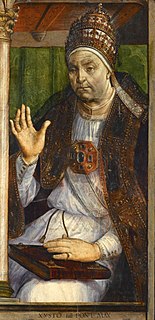
Pope Sixtus IV, born Francesco della Rovere, was head of the Catholic Church and ruler of the Papal States from 9 August 1471 to his death. His accomplishments as pope included the construction of the Sistine Chapel and the creation of the Vatican Archives. A patron of the arts, he brought together the group of artists who ushered the Early Renaissance into Rome with the first masterpieces of the city's new artistic age.
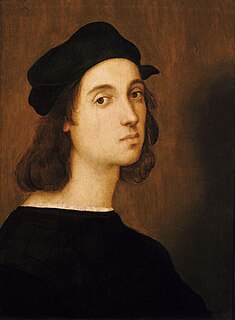
Raffaello Sanzio da Urbino, known mononymously as Raphael, was an Italian painter and architect of the High Renaissance. His work is admired for its clarity of form, ease of composition, and visual achievement of the Neoplatonic ideal of human grandeur. Together with Michelangelo and Leonardo da Vinci, he forms the traditional trinity of great masters of that period.

The Apostolic Palace is the official residence of the pope, the head of the Catholic Church, located in Vatican City. It is also known as the Papal Palace, the Palace of the Vatican and the Vatican Palace. The Vatican itself refers to the building as the Palace of Sixtus V, in honor of Pope Sixtus V, who built most of the present form of the palace.

Pinturicchio, or Pintoricchio, also known as Benetto di Biagio or Sordicchio, was an Italian painter during the Renaissance. He acquired his nickname because of his small stature and he used it to sign some of his artworks that were created during the fifteenth and sixteenth centuries.

The Corporal of Bolsena dates from a Eucharistic miracle in Bolsena, Italy, in 1263 when a consecrated host allegedly began to bleed onto a corporal, the small cloth upon which the host and chalice rest during the Canon of the Mass. The appearance of blood was seen as a miracle to affirm the Roman Catholic doctrine of transubstantiation, which states that the bread and wine become the Body and Blood of Christ at the moment of consecration during the Mass. Today the Corporal of Bolsena is preserved in a rich reliquary at Orvieto in the cathedral. The reddish spots on the cloth, upon close observation, show the profile of a face similar to those that traditionally represent Jesus Christ. It is said that the miraculous bleeding of the host occurred in the hands of an officiating priest who had doubts about transubstantiation. The "Miracle of Bolsena" is regarded by the Roman Catholic Church as a private revelation, meaning that Catholics are under no obligation to believe it although they may do so freely.
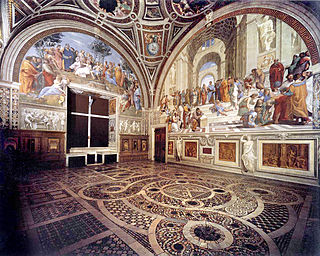
The four Raphael Rooms form a suite of reception rooms in the Apostolic Palace, now part of the Vatican Museums, in Vatican City. They are famous for their frescoes, painted by Raphael and his workshop. Together with Michelangelo's Sistine Chapel ceiling frescoes, they are the grand fresco sequences that mark the High Renaissance in Rome.

The Madonna della Seggiola or The Madonna della Sedia is an oil on panel Madonna painting by the High Italian Renaissance artist Raphael, executed c. 1513–1514, and housed at the Palazzo Pitti Collection in Florence, Italy. Although there is documentation on its arrival to its current location, Palazzo Pitti, it is still unknown who commissioned the painting; however, it has been in the Medici family since the 16th century.

The Disputation of the Sacrament, or Disputa, is a painting by the Italian Renaissance artist Raphael. It was painted between 1509 and 1510 as the first part of Raphael's commission to decorate with frescoes the rooms that are now known as the Stanze di Raffaello, in the Apostolic Palace in the Vatican. At the time, this room was known as the Stanza della Segnatura, and was the private papal library where the supreme papal tribunal met.

The Parnassus is a fresco painting by the Italian High Renaissance artist Raphael in the Raphael Rooms, in the Palace of the Vatican in Rome, painted at the commission of Pope Julius II. It was probably the second wall of the Stanza della Segnatura to be painted between 1509 and 1511, after La Disputa and before The School of Athens, which occupy other walls of the room.

The Expulsion of Heliodorus from the Temple is a fresco of the Italian renaissance painter Raphael. It was painted between 1511 and 1512 as part of Raphael's commission to decorate with frescoes the rooms that are now known as the Stanze di Raffaello, in the Apostolic Palace in the Vatican. It is located in the room that takes its name from it, the Stanza di Eliodoro.
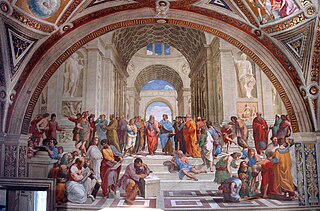
Pope Julius II, commissioned a series of highly influential art and architecture projects in the Vatican. The painting of the Sistine Chapel ceiling by Michelangelo and of various rooms by Raphael in the Apostolic Palace are considered among the masterworks that mark the High Renaissance in Rome. His decision to rebuild St Peter's led to the construction of the present basilica.
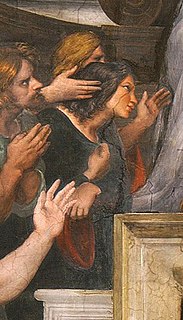
Felice della Rovere, also known as Madonna Felice, was the illegitimate daughter of Pope Julius II. One of the most powerful women of the Italian Renaissance, she was born in Rome around 1483 to Lucrezia Normanni and Cardinal Giuliano della Rovere, later Pope Julius II. Felice was well educated, became accepted into close courtly circles of aristocratic families, and formed friendships with scholars and poets through her education and genuine interest in humanism. Through the influence of her father, including an arranged marriage to Gian Giordano Orsini, she wielded extraordinary wealth and influence both within and beyond the Roman Curia. In particular, she negotiated a peace between Julius II and the Queen of France, and held the position of Orsini Signora for over a decade following the death of her husband in 1517. Felice further increased her power through a castle that she bought with money received from her father, the Castle at Palo, and through her involvement in the grain trade.

The Cardinal and Theological Virtues is a lunette fresco by Raphael found on the south wall of the Stanza della Segnatura in the Apostolic Palace of the Vatican. Three of the cardinal virtues are personified as statuesque women seated in a bucolic landscape and the theological virtues are depicted by putti. The fresco was a part of Raphael's commission to decorate the private apartments of Pope Julius II. These rooms are now known as the Stanze di Raffaello. After completing his three monumental frescoes Disputation of the Holy Sacrament, The Parnassus, and The School of Athens in the Stanza della Segnatura, Raphael painted the Cardinal and Theological Virtues in 1511.

The Renaissance in Rome occupied a period from the mid-15th to the mid-16th centuries, a period which spawned such masters as Michelangelo and Raphael, who left an indelible mark on Western figurative art. The city had been a magnet for artists wishing to study its classical ruins since the early 1400s. A revived interest in the Classics brought about the first archaeological study of Roman remains by the architect Filippo Brunelleschi and sculptor Donatello. This inspired a corresponding classicism in painting and sculpture, which manifested itself in the paintings of Masaccio and Uccello. Pisanello and his assistants also frequently took inspiration from ancient remains, but their approach was essentially cataloguing, acquiring a repertoire of models to be exploited later.

Sixtus IV Appointing Platina as Prefect of the Vatican Library is a fresco transferred to canvas by the Italian Renaissance artist Melozzo da Forlì, once decorating the Vatican Library, now housed in the Pinacoteca Vaticana in Rome.

Portrait of Pope Julius II is an oil painting of 1511–12 by the Italian High Renaissance painter Raphael. The portrait of Pope Julius II was unusual for its time and would carry a long influence on papal portraiture. From early in its life, it was specially hung at the pillars of the church of Santa Maria del Popolo, on the main route from the north into Rome, on feast and high holy days. Giorgio Vasari, writing long after Julius' death, said that "it was so lifelike and true it frightened everyone who saw it, as if it were the living man himself".

Tommaso Inghirami was a Renaissance humanist and orator. He was prefect of the Vatican Library for several years and secretary of the Fifth Lateran Council.
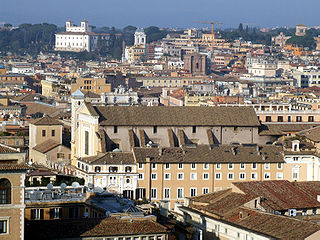
Santi Dodici Apostoli, commonly known simply as Santi Apostoli, is a 6th-century Roman Catholic parish and titular church and minor basilica in Rome, Italy, dedicated originally to St. James and St. Philip, whose remains are kept here, and later to all Apostles. Today, the basilica is under the care of the Conventual Franciscans, whose headquarters in Rome is in the adjacent building.

Santa Cristina is a Roman Catholic basilica church in Bolsena, province of Viterbo, region of Lazio, Italy. The church is best known for being the site of a Eucharistic Miracle in 1263, immortalized by The Mass at Bolsena by Raphael in the Vatican palace. It also was the burial site for the martyr and saint Christina of Bolsena.






















